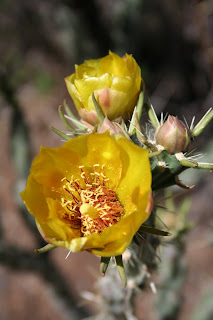 |
| Buckhorn Cholla flower buds (Cylindropuntia acanthocarpa) ready for harvest mid April in the Sonoran Desert. |
April of 2011 has proved to be my first successful cholla flower bud harvest. In the past I have never found an abundance of information on how to specifically and successfully harvest cholla flower buds for eating. For that reason I simply avoided it. However, instead of avoiding cholla buds due to lack of information I just went ahead and did it this year. It is a shame I haven't done this in the past, its rather quick, easy, and super abundant! Not quite as easy as saguaro fruit harvesting though.
 |
| Buckhorn Cholla flower (Cylindropuntia acanthocarpa). |
Here is how to harvest cholla flower buds:
1. Identify the species of cholla in the area you want to harvest in. I harvested west of Phoenix where Buckhorn Cholla is abundant. This particular cholla is ready to harvest mid April. Most other types of chollas are ready to harvest mid April also.
2. To collect cholla flower buds you will need some sort of tongs, such as a grilling tong. This allows you to twist the bud off of the plant so you don't get poked. You will also need some sort of bag, bucket, or basket. I used a plastic bag which wasn't the best choice due to the spines puncturing the plastic, but it still worked.
3. After collecting all the buds you want you will have to remove the spines. Some people roll the buds on the ground or on some sort of hardware cloth. I chose to burn the spines off which proved to be very effective. I would like to try removing spines with hardware cloth sometime though. After burning the spines off I thoroughly washed to buds off by swishing them around in several rinses of water.
 |
| Burning cholla bud spines off in the bottom of my grill. |
4. Lastly, I boiled the buds in water for about 30 minutes. Apparently some people don't boil their buds but I chose to in order to remove the oxalic acid. Once the buds are boiled they are ready to eat.
The buds that I ate plain were very good. I made the rest into a cholla bud salsa which was also excellent. According to everything I have read on-line cholla buds taste somewhere between asparagus and artichoke, and I would have to agree. The flavor is not overpowering but is very rich and tasty. As with other cacti the texture is slimy due to the mucilaginous nature of the tissue. Also from what I have read cholla buds are loaded with calcium as well as carbohydrates that help maintain blood sugar.
 |
| My cholla bud salsa. About 1 cup of chopped cholla buds, 1/4 of a small red onion, 1/2 lime juice, small amount of garlic powder, and 2 small tomatoes. |
Being this is my first time harvesting and eating cholla buds I would like to know if anyone else has experiences with cholla bud foraging. What species? How were spines removed? How were they cooked?























